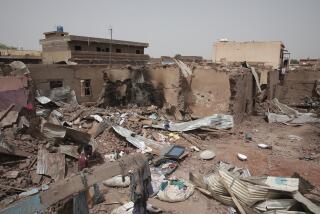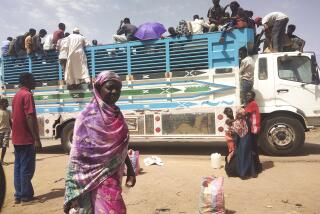U.N. Seeks $500 Million in Liberia Aid
UNITED NATIONS — Seeking nearly $500 million to help Liberia rebuild after 14 years of civil war, U.N. officials told international donors Thursday that this was the African nation’s best chance in decades to get back on its feet. They warned that it might be the last chance.
The world has a “crucial opportunity” to ensure that Liberia’s fragile peace does not come undone, said Mark Malloch Brown, administrator of the U.N. Development Program, which chaired the conference.
Last-minute hints of new pledges prompted U.N. and U.S. officials, who were leading the appeal, to express confidence that Liberia would not be let down. A U.N. study estimated that the country would require at least $488 million for its most urgent needs: demobilizing combatants -- some as young as 12 -- and rebuilding the nation’s infrastructure.
The United States has pledged $200 million to Liberia, which was founded in 1847 by freed American slaves. The European Commission has offered $120 million, and additional donations from European states, Canada and Japan are expected today to bring the total to more than $400 million.
The donor conference will gain a bit of drama today when Secretary of State Colin L. Powell and French Foreign Minister Dominique de Villepin meet almost exactly a year after they clashed here over U.S.-led plans to invade Iraq. France is expected to pitch in money to help persuade the U.S. to support a contested peacekeeping mission in the Ivory Coast, a former French colony.
Portrayal of Liberia as the linchpin to regional stability has broadened its appeal to reluctant donors.
“There’s a general recognition in the international community that by not dealing with Liberia, we’re destabilizing the whole region,” said Andrew Natsios, administrator of the U.S. Agency for International Development. “Unless we fix this, we’re not going to be able to fix the security situation in West Africa.”
After then-President Charles Taylor fled into exile last August, Liberians were told that peacekeepers were coming, child soldiers would trade their guns for schoolbooks and the war-ravaged country could finally begin to rebuild. But today, only two-thirds of the peacekeepers have arrived, fighting continues, and residents are struggling with a new set of problems.
Liberia is a tiny country, and almost all of its 3.3 million residents have been profoundly affected by the protracted conflict, U.N. aid groups say. A quarter of a million people have died in the civil war, most of them noncombatants.
Half the nation’s residents have been displaced from their homes. Killing, rape and kidnapping persist despite the peace accord, and child soldiers are drifting into neighboring countries to fight in other conflicts.
Natsios stressed that helping former soldiers -- men, women, and especially children -- resume productive lives was the key to the country’s revival. Most of all, Liberians, not foreign aid groups, must lead the way.
Despite the two nations’ historical ties, the U.S. resisted intervening militarily in Liberia at the height of the crisis last July to force regional leaders to get involved. Although Washington helped recruit West African countries to provide peacekeepers and eventually dispatched a flotilla of gunships off the coast to provide them with symbolic support, few American soldiers actually set foot in the country for more than a day at a time.
The U.S., however, has already spent about $100 million in humanitarian aid and will pay about $245 million for its share of the peacekeeping operation -- on top of the $200 million pledged at the conference.
“I cannot remember a country where we’ve pledged 40% of the total reconstruction budget,” Natsios said at a briefing on Liberia this week. “So I think it’s quite substantial.”
(BEGIN TEXT OF INFOBOX) * The price of fighting * The price of Liberia’s civil war can be seen, in part, in the nation’s declining quality of life. 1989 2003 Population (mil.) 2.54 3.30
% Arable land 4 1.97
Electricity production (millions of kilowatt-hours) 728* 469**
Exports (mil.) $505 $110***
Life expectancy: Male 53 47 Female 56 49
Births per 1,000 people 45 45.3
Deaths per 1,000 people 13 17.8
Infant mortality: Deaths per 1,000 births 119 132
*1990 estimate **2001 ***2002 Sources: CIA Factbook, World Almanac - Researched by Times graphics reporter Tom Reinken
More to Read
Sign up for Essential California
The most important California stories and recommendations in your inbox every morning.
You may occasionally receive promotional content from the Los Angeles Times.










